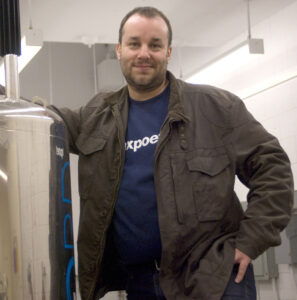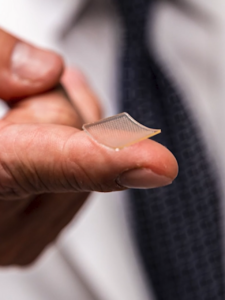Ronald Koder, professor of Physics in the Division of Science has developed a method to use microneedle patches to quantify the systemic concentration of proinflammatory cytokines that are associated with fatal outcomes in COVID-19. The study has the potential to change the current paradigm for clinical therapy in COVID-19 and other diseases by providing an early diagnostic indicator.

Koder’s new project has examined how Cytokine Release Syndrome (CRS) impacts the aftereffects of COVID-19.
“If you’re healthy and get COVID-19, your inflammation starts to build up, but your immune system gets rid of it before there are a lot of bad outcomes,” said Koder. “But if you are experiencing inflammation and your inflammatory pathways are already activated, COVID-19 kicks them into overdrive, and a lot of the damage caused is actually caused by your immune overreaction.”
Koder’s ongoing project with Dr. Dan Heller at Memorial Sloan Kettering involved developing implantable cancer biosensors for ovarian cancer.
“The first biomarker we worked on was interleukin-6 (Il-6), and it turned out that Il-6 is the most important cytokine in COVID-19 in cytokine release syndrome,” said Koder. “In retrospective studies, they have shown that IL-6 correlates with the highest death.”
As up to one-third of hospitalized COVID-19 patients develop cytokine release syndrome (CRS), early detection of cytokine levels can help health care providers predict the need for treatment.
“With an average timespan of fewer than 10 days from onset of symptoms to death from COVID-19 and a 50-80% mortality rate in adults who develop CRS, there is an urgent need for a robust triage system for hospitalized patients suffering from respiratory diseases or other situations that make them vulnerable to CRS,” said Koder. “The hope is that early detection of elevated cytokine levels can predict the need for treatment before the onset of symptoms.”
Collaborating with Dan Heller from Memorial Sloan Kettering and Robert Schwartz from Weill-Cornell, Koder’s team has repurposed the detection system that they developed for ovarian cancer.
“Robert Schwartz said that he needs a way to measure cytokines in real-time because now it takes at least 24 hours for the lab test,” added Koder. “We thought that we could take the microneedle technology and adapt it. And on the tips of these microneedles, we put the protein and carbon nanotubes that recognize these cytokines. When they bind to them, they undergo a large-scale conformational change, which changes the fluorescence emission wavelength of carbon nanotubes to which they’re attached.”

The team has created a working sensor for the cytokine most correlated to fatal outcomes in COVID-19. “We’ve shown we can quantify IL-6 in solution, patient fluids, and mice,” noted Koder. “We’re waiting for an IRB approval to try this on patients. “
The project will help develop new sensors that are capable of continuous tracking of pro-inflammatory cytokines using a noninvasive sensor patch and facilitate transient prognostic monitoring.
“The platform will enable bypassing several steps in the process of access to care, as disease progression could be remotely and continuously monitored by point-of-care devices, allowing for instantaneous follow-up and linkage to care,” said Koder. “In the long term, our technology promises to change the current paradigm for clinical therapy not just in COVID-19 but in other diseases where cytokine release syndrome plays a major role, changing current medical practice by providing an early diagnostic and prognostic indicator in patients with genetic risk factors, risk of disease recurrence, or to benchmark treatment.”